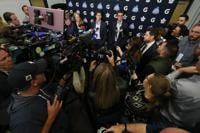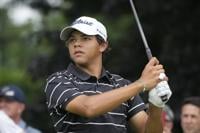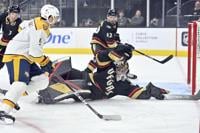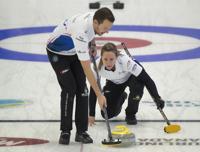TORONTO - A line of sports media members formed outside the Toronto Blue Jays' clubhouse earlier this month shortly after the team blew a seven-run lead and was eliminated from the post-season.
Managers and select players were set to speak in a nearby interview room but a big part of the story would come into focus once the locker-room door opened.
For local baseball scribes who couldn't do the same when normal access wasn't available in the pandemic-impacted 2020 post-season, it was a refreshing return to normal.
"You could hear people, look at people, see what they're feeling and try to explain that to the reader," said Toronto Sun sports columnist Steve Simmons.
Like other sports, remote coverage became the norm in 2020 and continued for many into 2021. Travel restrictions and closed locker-rooms left video interviews as the replacement for in-person interaction.
It has been a slow process, but things are finally getting back to normal.
"Being back in the locker-room in hockey, football, baseball, basketball — all of these places — it just makes the relationships and the storytelling better," said Stephen Whyno, who primarily covers hockey for The Associated Press.
"It just makes you feel like you're talking to people again."
The Blue Jays were also swept in the wild-card round in 2020, falling in two games to the Tampa Bay Rays. Toronto didn't make the playoffs last year.
When the Blue Jays were eliminated this time around, journalists could see pitcher Alek Manoah seated by his stall with a vacant, despondent look.
Infielder Bo Bichette held an impromptu scrum but struggled to get the words out. Jordan Romano, who blew the save in the stunning 10-9 Game 2 loss, fought back tears as teammates offered supportive hugs and handshakes.
"They were sort of offering their condolences," Simmons said. "If I'm not in there, I can't see this, I can't hear this and I can't explain this to readers. I was pretty darn pleased with the piece I got out of it."
Raw emotions were on full display that night. And just like the old days, reporters took it all in while scribbling notes and asking questions.
It was a rich storytelling opportunity and a complete switch from the staid post-game Zoom calls from two years ago at Tropicana Field.
"We all knew during that period of time that there was some layer of coverage that was missing," said Sportsnet baseball writer Ben Nicholson-Smith. "Thankfully we've been able to get that back."
While some comments were better than none, a big issue with video availabilities was that everyone on the call could use answers from a reporter's questions. In most cases, no other access options were possible.
Finding a usable quote — already a challenge in today's sports media world — was even tougher with an onscreen format that can easily lead to subject disengagement. Followup questions weren't always allowed.
In general, media access started to improve in 2021 but the Omicron variant later forced another wave of restrictions.
Regular attendance returned in most venues this year and many sports resumed pre-pandemic setups. Virtual availabilities have mostly been eliminated and on-site masking is sometimes required and usually encouraged.
Mark Lowes, an associate communications professor at the University of Ottawa, hasn't noticed much difference in standard game stories since the so-called return to normal.
"Where you would have a recognizable change and a benefit with full access, it comes back to the relationships," he said. "Finally you're in the stadium, you're at the game … you do have that opportunity to better massage that source relationship."
The baseball playbook is similar to the ones being used by other sports, leagues and federations across the country, with some variations.
Canada's lone NBA team, the Toronto Raptors, make select players and coaches available in an interview room but use tiered access to allow limited media members into the locker-room, citing league rules.
Busy scrums are again the norm on the NHL scene. The CFL, meanwhile, has not resumed post-game locker-room access with select players and coaches instead made available in a podium setting nearby.
"I think reduced access is just another pothole in the road to good journalism," said former Toronto Star sports media columnist Chris Zelkovich, now an instructor at the Toronto-based College of Sports Media.
"If you can't get the full story by talking to a variety of people, the story is not going to be as good."
In addition to networking opportunities, in-person staffing has allowed media members to get back to learning things you might not see if you're covering a game remotely.
"I do think that when we're there, you have your eyes open and you notice little interactions," said Nicholson-Smith. "It just adds to the depth.
"Even if it's not a singular quote or it's not necessarily one moment that's leading a story for you, over the course of a season you can pick up on different things and find ways to convey that to readers."
Often the most valuable part of a reporter's day is interacting with athletes, executives and colleagues during batting practice, a pre-game skate, walk-through or morning shootaround.
Access can be even better at road venues when a visiting team's local media presence isn't as strong.
"There's a real trust factor when you're around a team a lot," said Winnipeg Sun sports editor Ted Wyman. "The players know you and the coaches know you. That helps as a journalist — a lot."
This report by Ďă¸ŰÁůşĎ˛ĘąŇĹĆ×ĘÁĎ was first published Oct. 21, 2022.
Follow @GregoryStrongCP on Twitter.








































